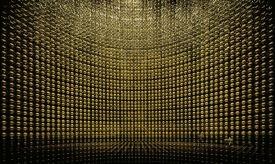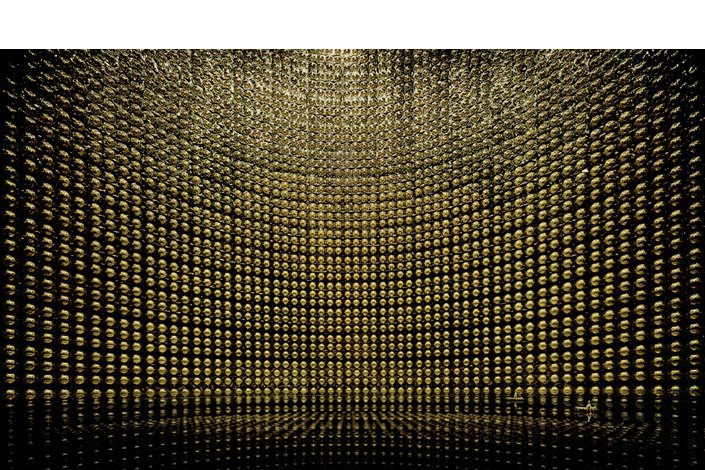Andreas Gursky, arguably the most famous contemporary photographer (and inarguably the most well-remunerated one, after a recent $3 million sale) has a new show at London’s White Cube Mason’s Yard Gallery. Gursky creates large-scale pictures of various aspects of modern life — apartment buildings, agriculture, shopping. He digitally manipulates and combines individual photos to give amazing depth of field and level of detail for everything he shows. The new show is dominated by pictures of a colorful celebration from Pyongyang, North Korea, the totalitarian system mirrored in the thousands of synchronized dancers, spectators holding up cards making individual pixels showing pictures of flowers and doves — or guns. But amongst the politics is a picture called Kamiokande:

Kamiokande, 2007, 222 x 357 cm,
© Andreas Gursky/DACS. Courtesy of Monika Sprüth/Philomene Magers, via Wallpaper (more photos — needless to say these immense and detailed pictures don’t reproduce at all well in the relatively few low-quality pixels available here).
Kamiokande is actually Kamioka-NDE — Kamioka Nucleon Decay Experiment: an immense tank of water located in Kamioka, Japan, outfitted with phototubes (the golden spheres), buried deep underground. It was originally built to detect the light given off by the decay of the protons in the water’s hydrogen and oxygen nuclei. However, the experimenters also realized that they would be able to see the products of neutrinos traversing the tank and, rarely, interacting with the water atoms. The main source of neutrinos was meant to be the reactions powering the sun, although in fact the first obvious detections came just 20 years ago from Supernova 1987a. Since then, Kamiokande has indeed observed solar neutrinos, thereby providing the first strong evidence that neutrinos do indeed have a small mass — and
sharing the 2002 Nobel.
To get a sense of the immense scale of this experiment, look at the splotches floating on lower right. Those are technicians, paddling around in boats on the surface of the water filling the tank. Their work has been crucial over the last few years: back in 2001, thousands of the phototubes imploded, probably starting with a single one, the shock of that cascading through the structure in a chain reaction. Fortunately, they were able to replace the broken tubes, and for the last few years have been running a slightly different experiment, K2K, an oscillation experiment similar to MINOS and MiniBooNE, which I’ve discussed previously here and, more recently, here.
These experiments are somewhat typical of modern Big Science — huge pieces of hardware (albeit mostly empty in this case), international collaboration taking years to measure the lightest particles we’ve found. And the photo is typical Gursky — humans dwarfed by their own inventions, although more happily than his photos of Pyongyang rallies for the Dear Leader, or of apartment-dwellers dwarfed by their own houses.
<!– –>
–>
One response to “Art, Science, Neutrinos”
It’s a great exhibition, and I randomly bumped into my parents looking at that very picture!